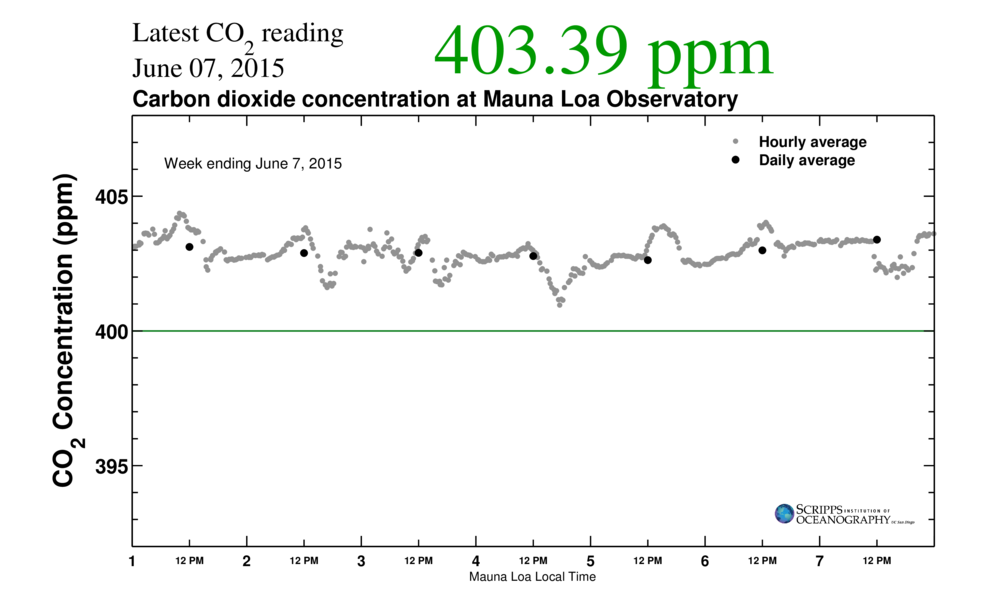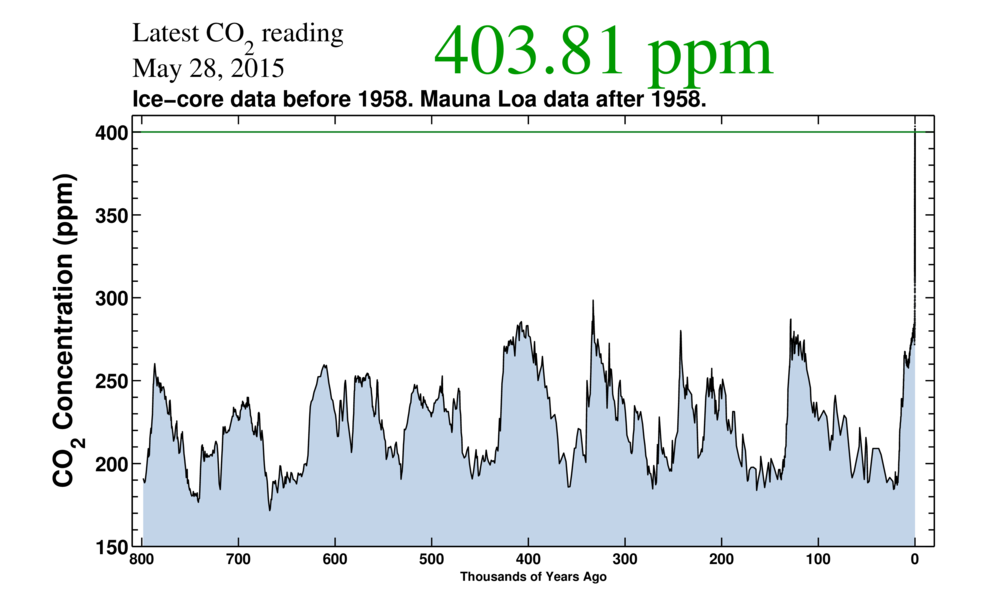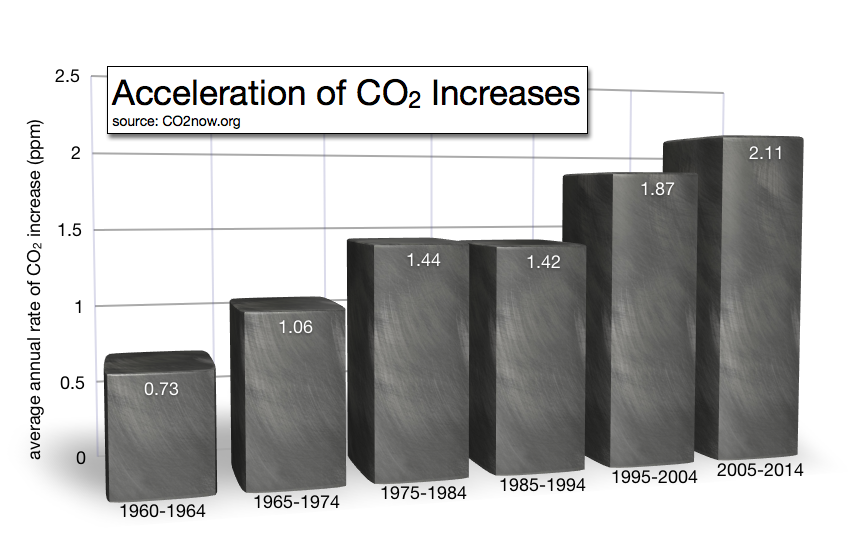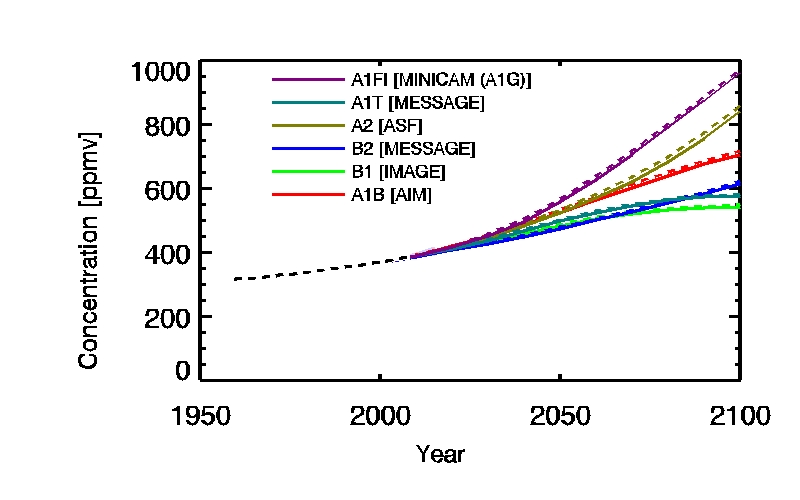We recently reached an interesting milestone: for the first time in human history, the global monthly average carbon dioxide concentration in the atmosphere exceeded 400 parts per million (ppm). This wasn’t the first time that the 400 ppm barrier had been broken; that occurred at Mauna Loa back in May 2013. But it was the first time that the global monthly average reached this high. In March 2014, the monthly average was 398.1 ppm; in March 2015 it was 400.83 ppm.
The next grim milestone will occur when the average annual concentration exceeds 400 ppm. In 2013, that average was 396.48; in 2014, it was 398.55. Given that the rising concentration of CO2 now exceeds 2 ppm per year, this all but guarantees that 2015 will be the year this happens.
But I await another milestone: the last measurement below 400 ppm. When will that happen?
The best place to watch near-real time CO2 measurements is the website of the Keeling Curve, https://scripps.ucsd.edu/programs/keelingcurve/. Disaster junkies such as myself can tune in to see the latest postings. Here are the most recent numbers:

Carbon dioxide varies throughout the year, with September-October producing the lowest readings, and April-May-June producing the highest. Last September-October readings were a bit above 395 ppm; the year before that, they were about 393 ppm. Remember that CO2 is increasing just over 2 ppm per year. So it’s not hard to imagine that this September-October the readings will fall near 397 ppm, and in 2016 they will be about 399 ppm, just below the brink. This suggests the last sub-400 readings should occur between September-October 2017. And then that’s it. They can throw away the “3” because they’re never going to need it again.
Think about this: When that last measurement below 400 ppm is taken, there will never be another such reading in your lifetime. Nor in your children’s lifetime. Nor in your grandchildren’s and great-grandchildren’s lifetimes. The next time a sub-400 number occurs, will anyone be there to measure it? Let’s not get too far ahead of ourselves in presuming the survivability of our species.
So what does this milestone mean? Well, for one thing, it marks a new era for our species. When Homo sapiens emerged about 200,000 years ago, CO2 was closer to 250 ppm, as you can see in this 800,000-year chart of CO2:

We’ve come a long way, baby. In 800,000 years, carbon dioxide numbers have never been this high; in fact, we need to go back over three million years to find comparable numbers. Human beings have never lived in a world with this much carbon dioxide.
But why stop at 400 ppm? The rate of CO2 increase is accelerating. Between 1965-1974, the average annual jump in CO2 was 1.06 ppm. Between 2005-2014, that rate doubled to 2.11 ppm.

How long will it take us to reach 500 ppm CO2? There are many variables in such a calculation (note that between 1985-1994, the rate of increase went slightly down compared to the previous decade). A variety of models produced by the IPCC show a range of projected increases:

While these projections differ widely at the year 2100, they also show that in most cases, CO2 should exceed 500 ppm by the year 2050. That’s only 35 years away. A child born today will barely have moved out of Mom’s basement (at least, judging by some millennials) by the time CO2 reaches 500 ppm. The hundred-point rise between 300 to 400 ppm took about a century; the rise between 400 to 500 ppm will take only about 35 years, and with accelerating rates, the rise to 600 ppm will happen even faster.
We have created a different world. No one intended to create it at the start of the Industrial Revolution. But ton after ton of coal shoveled year after year into row upon row of smoking furnaces and hissing boilers, stretching to the crimson horizon, has spawned a sulfurous monster, a sooty golem who now awakens to stalk the earth.
In Part 2 we’ll examine what living in a 400 ppm world means.
